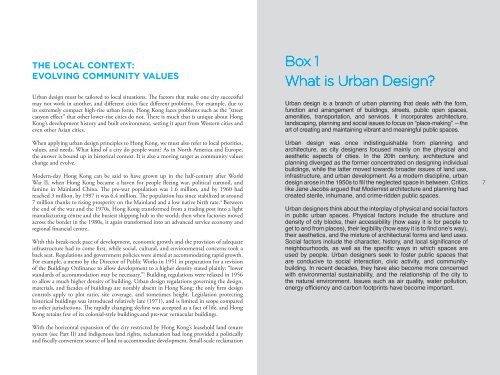Treating the Symptoms - A Critical Review of ... - Civic Exchange
Treating the Symptoms - A Critical Review of ... - Civic Exchange
Treating the Symptoms - A Critical Review of ... - Civic Exchange
- No tags were found...
Create successful ePaper yourself
Turn your PDF publications into a flip-book with our unique Google optimized e-Paper software.
The Local Context:Evolving Community ValuesUrban design must be tailored to local situations. The factors that make one city successfulmay not work in ano<strong>the</strong>r, and different cities face different problems. For example, due toits extremely compact high-rise urban form, Hong Kong faces problems such as <strong>the</strong> “streetcanyon effect” that o<strong>the</strong>r lower-rise cities do not. There is much that is unique about HongKong’s development history and built environment, setting it apart from Western cities andeven o<strong>the</strong>r Asian cities.When applying urban design principles to Hong Kong, we must also refer to local priorities,values, and needs. What kind <strong>of</strong> a city do people want? As in North America and Europe,<strong>the</strong> answer is bound up in historical context. It is also a moving target as community valueschange and evolve.Modern-day Hong Kong can be said to have grown up in <strong>the</strong> half-century after WorldWar II, when Hong Kong became a haven for people fleeing war, political turmoil, andfamine in Mainland China. The pre-war population was 1.6 million, and by 1960 hadreached 3 million, by 1997 it was 6.4 million. The population has since stabilized at around7 million thanks to rising prosperity on <strong>the</strong> Mainland and a low native birth rate. 4 Between<strong>the</strong> end <strong>of</strong> <strong>the</strong> war and <strong>the</strong> 1970s, Hong Kong transformed from a trading post into a lightmanufacturing centre and <strong>the</strong> busiest shipping hub in <strong>the</strong> world; <strong>the</strong>n when factories movedacross <strong>the</strong> border in <strong>the</strong> 1980s, it again transformed into an advanced service economy andregional financial centre.With this break-neck pace <strong>of</strong> development, economic growth and <strong>the</strong> provision <strong>of</strong> adequateinfrastructure had to come first, while social, cultural, and environmental concerns took aback seat. Regulations and government policies were aimed at accommodating rapid growth.For example, a memo by <strong>the</strong> Director <strong>of</strong> Public Works in 1951 in preparation for a revision<strong>of</strong> <strong>the</strong> Buildings Ordinance to allow development to a higher density stated plainly: “lowerstandards <strong>of</strong> accommodation may be necessary.” 5 Building regulations were relaxed in 1956to allow a much higher density <strong>of</strong> building. Urban design regulations governing <strong>the</strong> design,materials, and facades <strong>of</strong> buildings are notably absent in Hong Kong; <strong>the</strong> only firm designcontrols apply to plot ratio, site coverage, and sometimes height. Legislation protectinghistorical buildings was introduced relatively late (1971), and is limited in scope comparedto o<strong>the</strong>r jurisdictions. The rapidly changing skyline was accepted as a fact <strong>of</strong> life, and HongKong retains few <strong>of</strong> its colonial-style buildings and pre-war vernacular buildings.With <strong>the</strong> horizontal expansion <strong>of</strong> <strong>the</strong> city restricted by Hong Kong’s leasehold land tenuresystem (see Part II) and indigenous land rights, reclamation had long provided a politicallyand fiscally convenient source <strong>of</strong> land to accommodate development. Small-scale reclamationBox 1What is Urban Design?Urban design is a branch <strong>of</strong> urban planning that deals with <strong>the</strong> form,function and arrangement <strong>of</strong> buildings, streets, public open spaces,amenities, transportation, and services. It incorporates architecture,landscaping, planning and social issues to focus on “place-making” —<strong>the</strong>art <strong>of</strong> creating and maintaining vibrant and meaningful public spaces.Urban design was once indistinguishable from planning andarchitecture, as city designers focused mainly on <strong>the</strong> physical andaes<strong>the</strong>tic aspects <strong>of</strong> cities. In <strong>the</strong> 20th century, architecture andplanning diverged as <strong>the</strong> former concentrated on designing individualbuildings, while <strong>the</strong> latter moved towards broader issues <strong>of</strong> land use,infrastructure, and urban development. As a modern discipline, urbandesign arose in <strong>the</strong> 1950s to fill <strong>the</strong> neglected space in between. Criticslike Jane Jacobs argued that Modernist architecture and planning hadcreated sterile, inhumane, and crime-ridden public spaces.Urban designers think about <strong>the</strong> interplay <strong>of</strong> physical and social factorsin public urban spaces. Physical factors include <strong>the</strong> structure anddensity <strong>of</strong> city blocks, <strong>the</strong>ir accessibility (how easy it is for people toget to and from places), <strong>the</strong>ir legibility (how easy it is to find one’s way),<strong>the</strong>ir aes<strong>the</strong>tics, and <strong>the</strong> mixture <strong>of</strong> architectural forms and land uses.Social factors include <strong>the</strong> character, history, and local significance <strong>of</strong>neighbourhoods, as well as <strong>the</strong> specific ways in which spaces areused by people. Urban designers seek to foster public spaces thatare conducive to social interaction, civic activity, and communitybuilding.In recent decades, <strong>the</strong>y have also become more concernedwith environmental sustainability, and <strong>the</strong> relationship <strong>of</strong> <strong>the</strong> city to<strong>the</strong> natural environment. Issues such as air quality, water pollution,energy efficiency and carbon footprints have become important.7
















